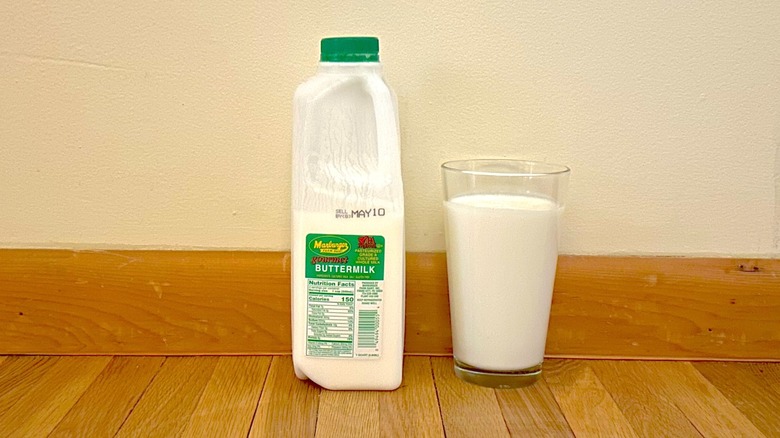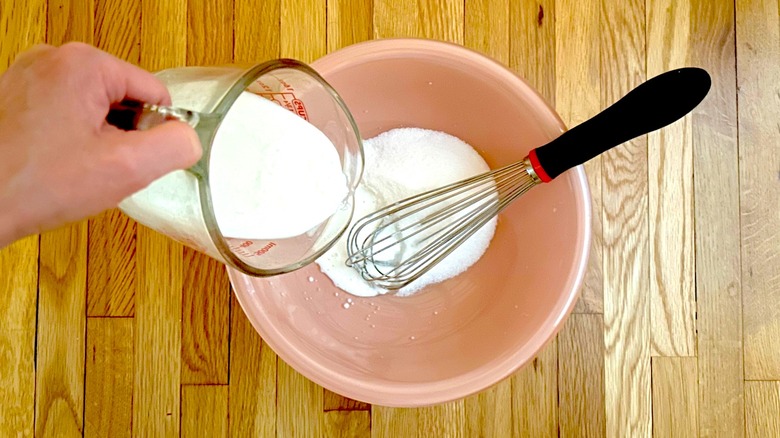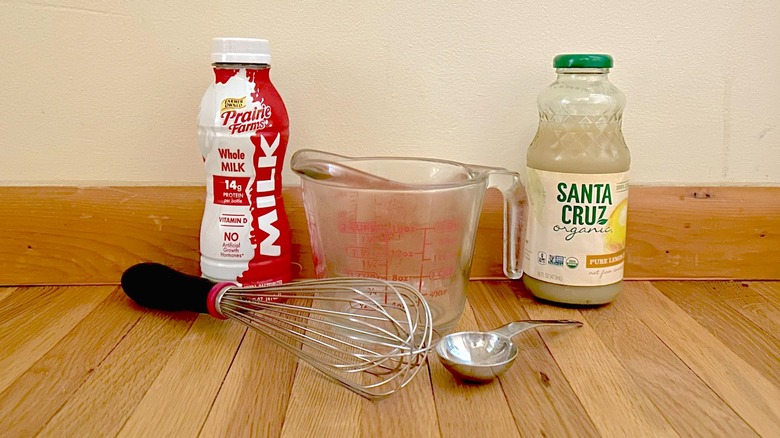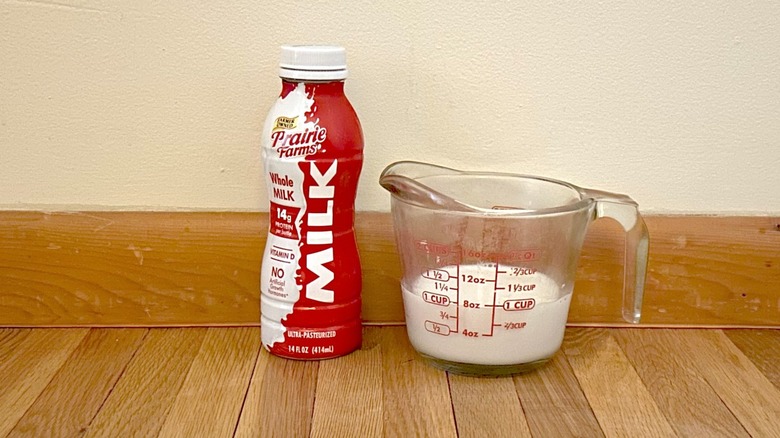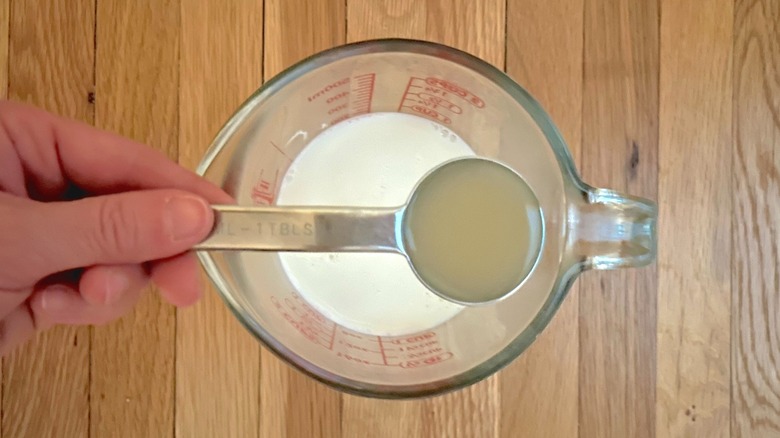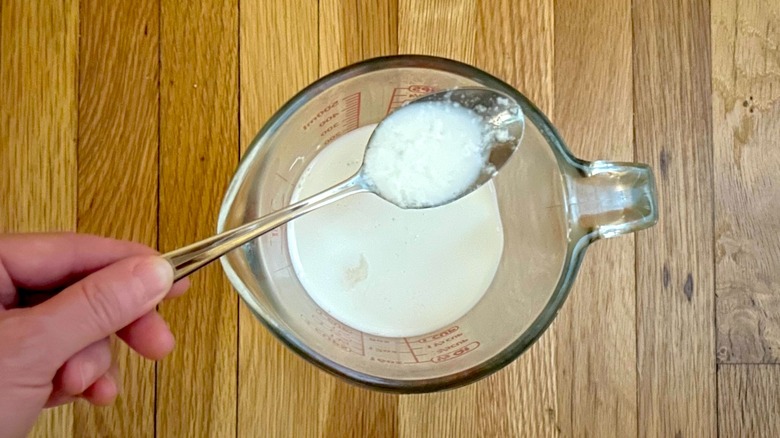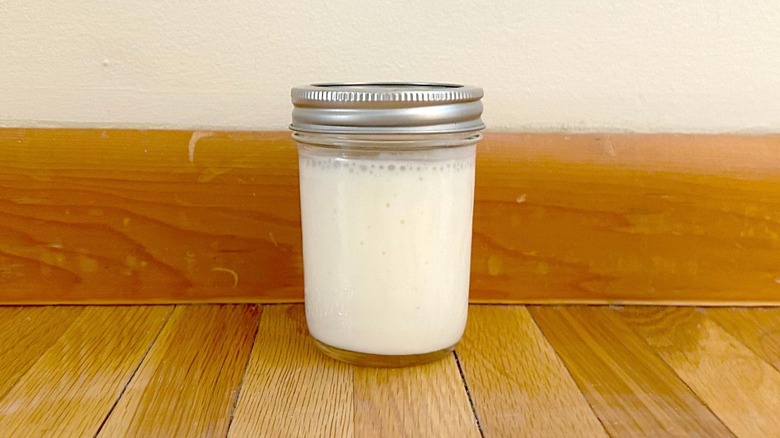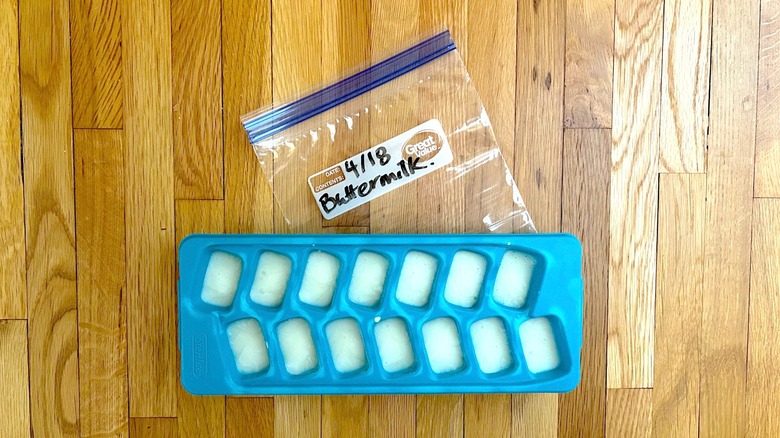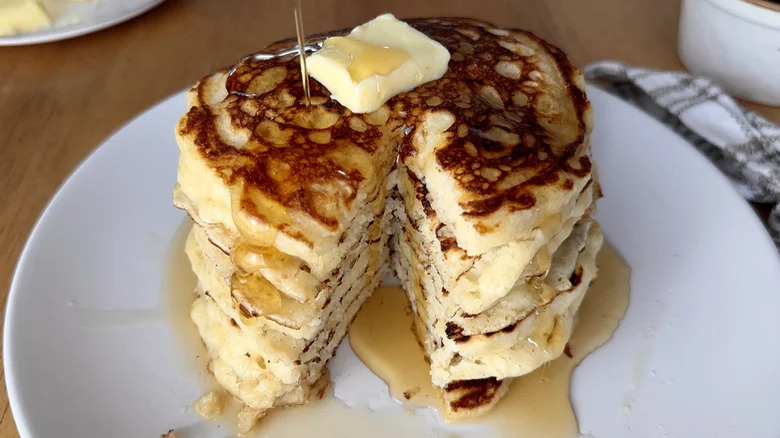How To Make Buttermilk With 2 Everyday Ingredients
Countless recipes, from the most luscious quickbreads and impossibly flaky biscuits to lighter-than-air pancakes and tangy salad dressings, call for one magic ingredient: buttermilk. Buttermilk can help leaven dough or batter, tenderize proteins, and confer a pungent acidic flavor and aroma lacking in milk alone. Those varieties containing live active cultures are also loaded with probiotics that can help improve your gut microbiome, strengthen your immune response, enhance digestion, and maximize the absorption of vitamins and minerals, among other purported health benefits.
That said, buttermilk is one of those ingredients that people seldom keep on hand. While substitutes exist, they are often less effective at mimicking the characteristics of the real deal. Fear not, however, as all is not lost. The next time you find yourself in a pickle without buttermilk for a recipe, save yourself the trip to the grocery store and follow these simple instructions for making buttermilk at home with two everyday ingredients you likely already have in your refrigerator.
What is buttermilk?
Before delving into how to make buttermilk at home, it is helpful to understand what it is and where it comes from. Historically, buttermilk was a by-product of the butter-making process. Once the cream was churned into butter, it was left to rest. The resulting sour liquid would become infused with cultures that would enhance its shelf-life beyond regular raw milk. Today, buttermilk is produced by taking pasteurized milk and infusing it with lactic acid bacteria, causing it to ferment, not unlike kefir or yogurt. Commercially produced buttermilk is sold in containers ranging in fat content from full-fat to skim, having a more dense texture than its classic iteration.
Buttermilk's superpower is its acidity. This can activate leaveners and denature gluten proteins in baked items, transforming them into something far more luscious and pillowy. When used in savory recipes, like dressings or marinades, it can also help to provide complexity to a dish, balancing sweet, salty, spicy, bitter, and umami-rich flavors. Though yogurt and sour cream can be substituted, their texture, fat content, and acidity may differ, making them more or less efficient as a facsimile for buttermilk. A better bet is to produce it yourself, which is simple and incredibly effective in any recipe.
Tools and ingredients you'll need to make buttermilk
To make buttermilk, you'll need a measuring cup, measuring spoon, and a whisk. Ingredients-wise, all that's required is whole milk as well as lemon juice or distilled vinegar.
Pour milk into measuring cup
Begin by pouring one cup of whole milk into a measuring cup. We recommend against using low or nonfat milk as the texture will not be thick enough. If you are seeking to produce a dairy-free alternative, oat milk or coconut milk would be the best options in terms of texture.
Add lemon juice or distilled vinegar
Next, you will want to add one tablespoon of lemon juice or distilled vinegar to the milk and whisk it to combine the ingredients. Apple cider or rice wine vinegar can also be used, but have a more distinct flavor, with the former being more pungent and the latter sweeter.
Do not attempt to use any other kind of vinegar for this purpose, particularly red wine or balsamic vinegar. Though you can use jarred lemon juice if you prefer freshly squeezed, you may want to pop the lemon into the microwave for 20 seconds to maximize the amount of liquid you can extract from the fruit.
Wait ten minutes
After sitting for ten minutes, your buttermilk is ready to use in any recipe. You will want to use it immediately for the best quality, especially when adding it to baked goods.
How long does buttermilk last?
As a general rule of thumb, cultured buttermilk safely stored in the refrigerator has a longer shelf-life than regular milk due to the presence of lactic acid. Homemade buttermilk will have this same benefit once you have added your acid of choice to your milk and allowed it to stand for ten minutes. An unopened container of buttermilk will typically be safe to consume up to two weeks beyond its expiration date. An open container of buttermilk should last for 14 days. When making homemade buttermilk, it is best to use it right away. If you have leftovers, transfer them into a clean and sanitized mason jar and place them in the refrigerator for up to 14 days.
Because of its naturally sour aroma and clumpy texture, it can be difficult to assess whether buttermilk has gone rancid. That said, if you notice a distinctly foul aroma, change in color, notably denser texture, or obvious appearance of mold, you should discard the buttermilk, store-bought or homemade.
How should you store buttermilk?
Store buttermilk in the refrigerator in its original container when purchased, or in a clean, sanitized mason jar if you are making it yourself. If you want to extend the shelf-life of your buttermilk, you can freeze it for up to three months. The easiest way to freeze buttermilk is to transfer it into ice cube trays. You can scoop the buttermilk into the ice cube trays using a one-tablespoon measure to deliver consistent-sized cubes. Once these are frozen, pop the buttermilk cubes out and place them in a freezer bag labeled with the date for easy retrieval for any recipe.
Note that the texture of the buttermilk may change after freezing, becoming somewhat crystallized. You will want to thaw buttermilk cubes in the refrigerator overnight or gently for a few seconds in the microwave and whisk them together well before adding them to any recipe.
Recipes using buttermilk
We have already noted the utility of buttermilk in all kinds of baked goods. One of the most common recipes you will find it in is pancakes. Basic buttermilk pancakes will develop huge air pockets that create perfect crevices for maple syrup to nestle into. In these fluffy lemon ricotta pancakes, the buttermilk helps to lighten the cheese, giving the pancakes a moist yet not overly heavy texture and a tangy flavor that perfectly juxtaposes the syrupy macerated berries.
Another classic recipe in which buttermilk features prominently is the biscuit. You will love this iteration of buttermilk biscuits and sausage cream gravy that is the perfect hearty breakfast for a cold winter day. The buttermilk helps to create those perfect pull-apart layers that make biscuits the ideal vessel for this stick-to-your-ribs gravy, absorbing all that glorious fat and dairy without falling apart or becoming soggy.
Lastly, if you are trying to make the perfect red velvet cake, look no further than buttermilk to keep it moist, make it taller and airier, and add a tangy element to balance that sweet and rich cream cheese frosting. This is a place where those frozen cubes of buttermilk are ideal. Once thawed and added to the batter, they will blend in beautifully without any notable change in texture.
